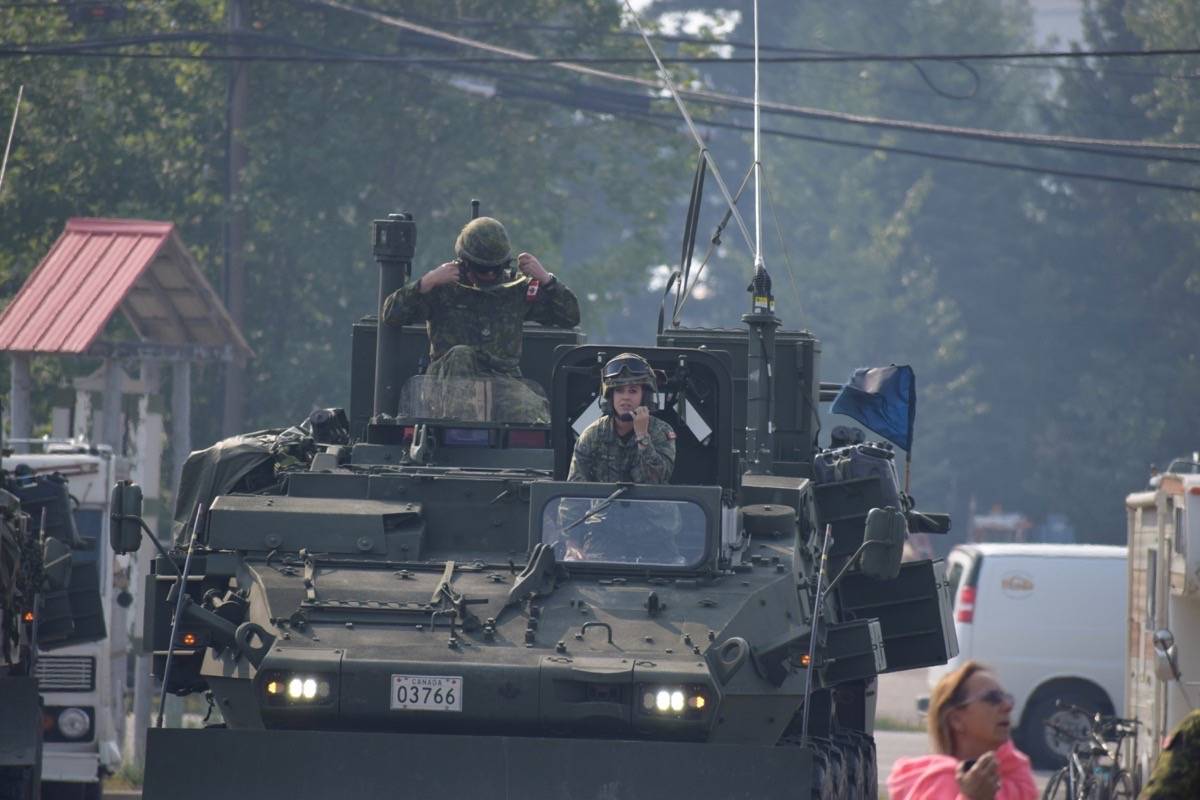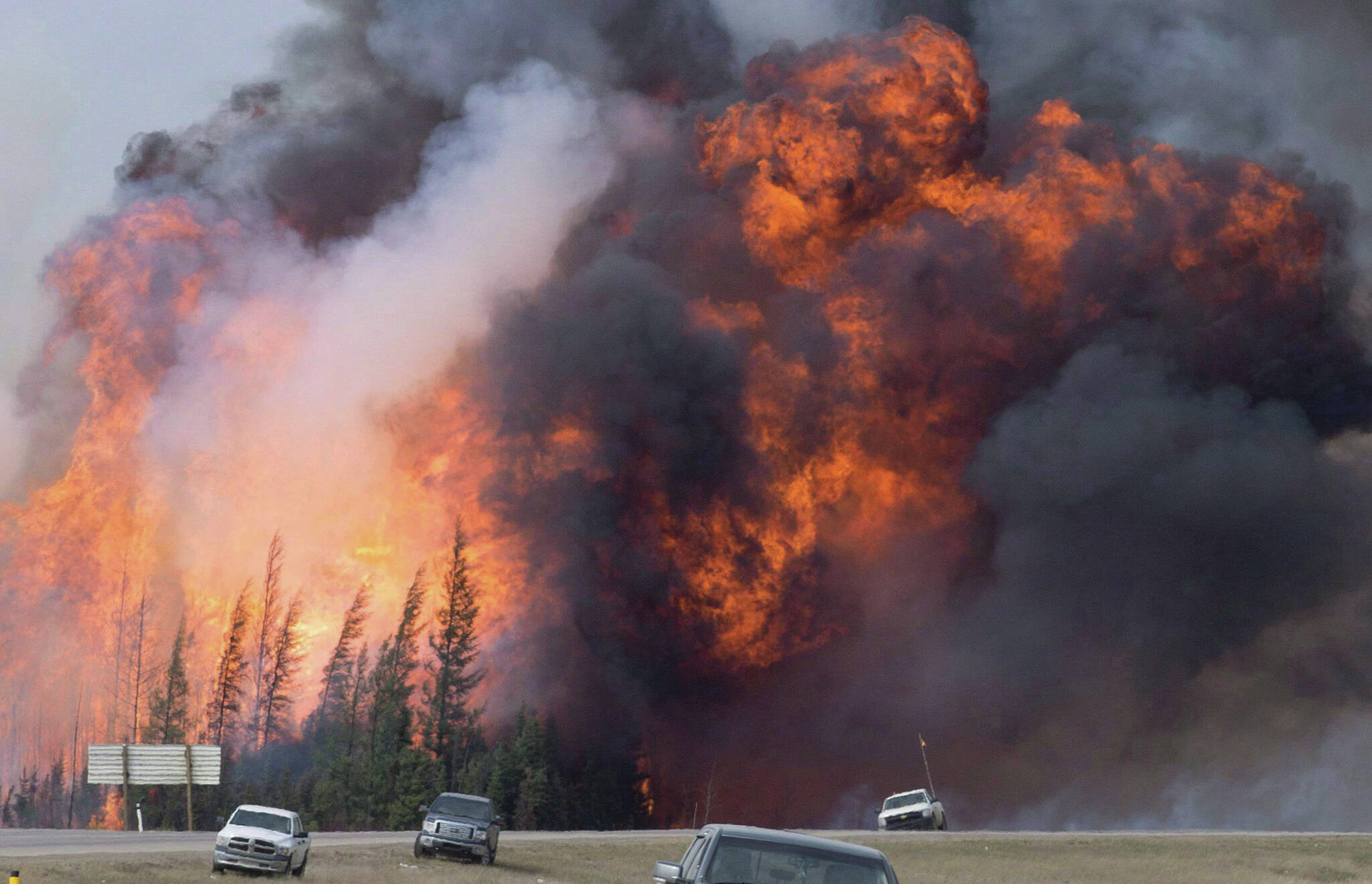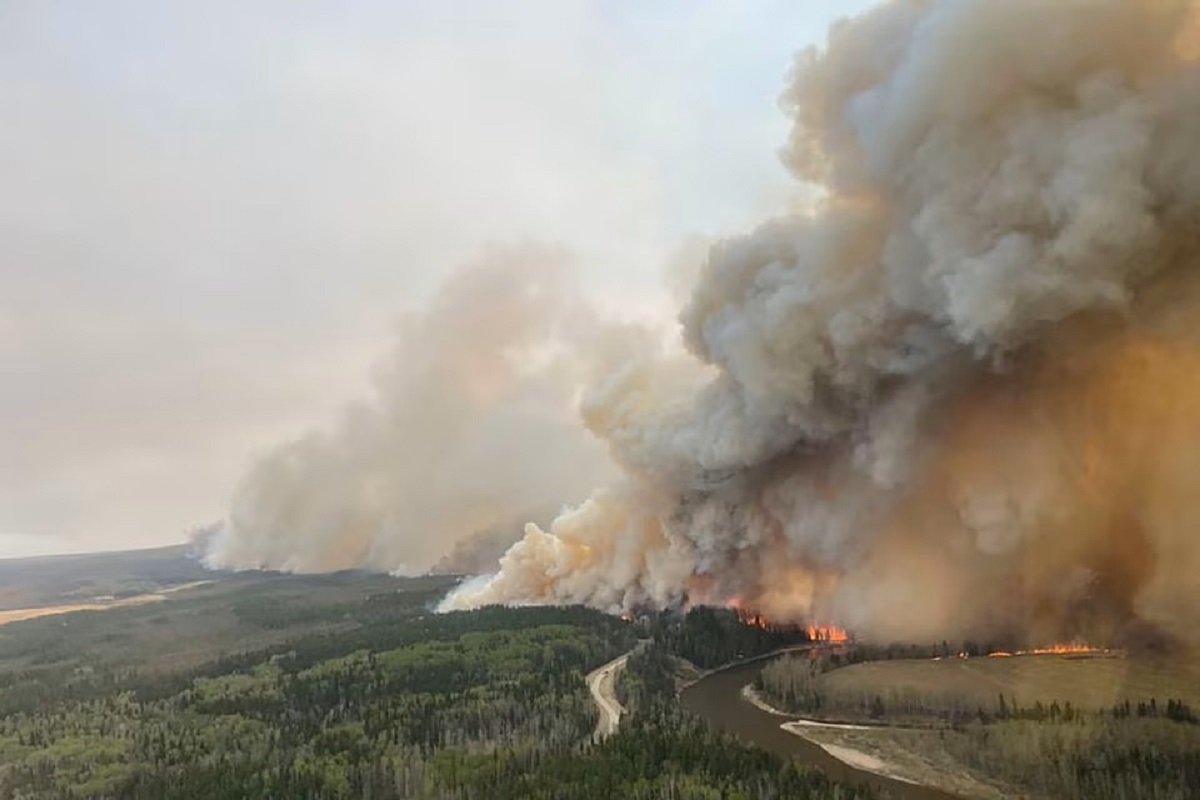News
Canada Deploys Armed Forces to Tackle Fast-Spreading Wildfires

Canada is sending military forces to British Columbia to combat fast-moving wildfires, Prime Minister Justin Trudeau announced on Sunday, as the western province battles flames that have forced the evacuation of more than 35,000 people.
British Columbia announced a state of emergency and banned non-essential travel to make room for evacuees and firefighters, and advised drone operators and those shooting photographs of the fires to keep a safe distance from the rescue personnel.
West Kelowna Fire Chief Jason Brolund expressed optimism after four days of battling “epic” fires. He claimed conditions had improved, allowing firefighters to put “boots on the ground” and drop water to put out the fires that threatened the 150,000-person town.
“Things are looking up. We’re now feeling like we’re moving forward rather than backward, which is fantastic…” Brolund stated to the Canadian Broadcasting Corporation. He did, however, warn of challenging days ahead in containing the McDougall Creek fire.
Forest fires are not unusual in Canada, but the spread of blazes and interruptions highlight the severity of the country’s worst wildfire season on record, which some scientists attribute to climate change.
Other blazes, aggravated by extreme drought, have been reported closer to the border and in the Pacific Northwest of the United States.
Just across the border in Washington state, firefighters were battling two major fires, the Grey Fire and the Oregon Road Fire, which had charred over 20,000 acres of forest area and damaged over 100 houses.
In Canada, officials urged individuals residing in evacuation zones to leave promptly in order to preserve their lives and avoid firefighters from dying while attempting to save them.
Officials have not yet estimated the overall number of buildings destroyed. Social media videos and photographs showed the damage of structures and automobiles, as well as massive flames devouring large trees.
The Canadian government-owned Trans Mountain pipeline and its expansion project, which runs through the interiors of British Columbia to the Pacific Coast, were unharmed by the fires, a company representative said on Sunday.
The pipeline expansion’s Coquihalla section, southwest of Kamloops, is the closest to a fire zone.
“Underground pipelines are typically buried a few feet below the surface and are protected from fire by the soil and the constant movement of liquid moving through the pipeline,” said the spokeswoman.
The flames have depleted local resources and drew assistance from the federal authorities as well as 13 other countries. At least four firefighters have perished while on the job.
Approximately 140,000 square kilometres (54,054 square miles) of land, roughly the size of New York state, have already been burnt, with smoky cloud stretching as far east as the United States. Due to extensive drought-like conditions, officials predict that the fire season will last until September.
Canada has spent more on battling and suppressing wildfires than on sustaining its firefighting people and programme since 2009.
A wildfire raging 2,000 kilometres to the north in Yellowknife, the capital city of the Northwest Territories, forced the evacuation of nearly all of its 20,000 residents last week.
The fire is currently not projected to reach city borders by the end of the weekend, according to officials, with some rain and cooler temperatures assisting in slowing its progress.
Krista Flesjer, who evacuated from the city with her pets, described the journey as difficult.
“I was afraid of getting caught up in the fires that were coming across the road,” she explained.
Flesjer’s major concern is whether her house, which is only two years old, would survive.
The TransCanada route in British Columbia was closed near Chase, some 400 kilometres northeast of Vancouver. The highway serves as the main east-west conduit for thousands of motorists and lorries travelling to Vancouver, Canada’s busiest port.
Kip Lumquist, who works at a gift shop in Craigellachie, a tourist destination along the route, said she has seen a lot of devastation in the last week.
“It was insane. “We couldn’t see the hills, mountains, trees, or anything for probably two and a half days,” Lumquist explained. “I drive a white car, and when I walked out to get in my car… it was just black.” It’s a disaster for the community.”
Other Canada News
China Bans Chinese Tourists from Visiting Canada
News
Britain Must Be Ready for War in 3 Years, Warns New Army Chief

The new head of the Army has stated that Britain must be prepared to fight a war within three years.
Gen Sir Roland Walker has issued a warning about a variety of risks in what he calls a “increasingly volatile” environment.
However, he stated that war was not inevitable and that the Army had “just enough time” to prepare to prevent conflict.
He stated that the Army’s fighting capacity would be doubled by 2027 and tripled by the end of the decade.
Gen Walker warned that the Britain was under threat from a “axis of upheaval” in his first speech as Prime Minister on Tuesday.
Among the primary concerns confronting the Britain in the next years, as noted by the general in a briefing, is an enraged Russia, which may seek vengeance on the West for helping Ukraine, regardless of who wins the war.
He stated: “It doesn’t matter how it finishes. I believe Russia will emerge from it weaker objectively – or completely – but still very, very dangerous and seeking some form of retaliation for what we have done to assist Ukraine.”
Britain’s Government Defence Review and Military Challenges
He also warned that China was determined to retake Taiwan, and Iran was likely to seek nuclear weapons.
He stated that the threats they posed may become particularly acute in the next three years, and that these countries had formed a “mutual transactional relationship” since the war in Ukraine, sharing weaponry and technology.
However, he stated that the path to conflict was not “inexorable” if the UK re-established credible land troops to assist its deterrent strategy for avoiding war.
In his speech, he described his force of slightly over 70,000 regular troops as a “medium-sized army” and made no direct call for additional resources or men.
However, he pushed the British Army to adapt swiftly, focussing on technology such as artificial intelligence and weaponry rather than numbers.
His ultimate goal is for the Army to be capable of destroying an opponent three times its size.
This would entail firing quicker and farther, he said, aided by lessons learnt from the Ukraine war.
The general’s speech at the Royal United Services Institute land warfare conference comes only one week after the government began a “root and branch” defence review to “take a fresh look” at the challenges facing the armed services.
Defence Secretary John Healey launched the assessment, describing the existing status of the armed forces as “hollowed-out” and stating that “procurement waste and neglected morale cannot continue”.
According to the most recent Ministry of Defence (MoD) numbers from April 2024, the Britain’s regular Army forces total 75,325 troops (excluding Gurkhas and volunteers).
That figure has been declining in recent years, as recruiting has failed to match retention. The previous Conservative administration lowered the planned headcount from 82,000 to 72,500 by 2025.
Members of the NATO military alliance have agreed to spend at least 2% of GDP on defence by 2024, but several countries are unlikely to fulfil this goal.
The Britain presently spends 2.3% of its GDP on defence. Prime Minister Sir Keir Starmer has previously stated that the defence review will include a “roadmap” for increasing this to 2.5%, however he has yet to provide a date for this promise.
Source: BBC
News
Katie Ledecky Hopes For Clean Races At Paris Olympics In The Aftermath Of The Chinese Doping Scandal

PARIS — Katie Ledecky is looking for clean Olympic races. On Wednesday, Hope had pretty much reached her limit.
The American swimmer hopes to add to her six gold medals as she competes in the 400, 800, and 1,500 meters at the Paris Games. Her program starts with the heavy 400 on Saturday, featuring Ariarne Titmus and Summer McIntosh.

Katie Ledecky | ESPN Image
Katie Ledecky Hopes For Clean Races At Paris Olympics In The Aftermath Of The Chinese Doping Scandal
The 27-year-old Katie is competing in her fourth Summer Olympics, but the first since a doping scandal involving almost two dozen Chinese swimmers who tested positive for a banned chemical before the Tokyo Games — yet were permitted to compete with no consequences. The controversy has raised serious worries regarding the effectiveness of anti-doping initiatives.

Katie Ledecky | Vogue Image
“I hope everyone here is going to be competing clean this week,” Ledecky claimed. “But what truly counts is, were they training cleanly? Hopefully this has been the case. Hopefully, there has been worldwide testing.”
The International Olympic Committee has expressed concern over the ongoing US investigation into possible doping by Chinese swimmers. While awarding the 2034 Winter Olympics to Salt Lake City on Wednesday, the IOC urged Utah officials to do whatever they could to stop the FBI investigation.
“I think everyone’s heard what the athletes think,” Katie added. “They seek transparency. They want more answers to the remaining questions. At this point, we are here to race. We are going to race whoever is in the lane next to us.
“We are not paid to conduct the tests, so we trust those who follow their regulations. That applies both today and in the future.

Katie Ledecky | ESPN Image
Katie Ledecky Hopes For Clean Races At Paris Olympics In The Aftermath Of The Chinese Doping Scandal
SOURCE | AP
News
London Heatwave Alert: High Temperatures Set to Soar to 29C Next Week

As the summer holidays begin, London may experience an official heatwave with temperatures reaching up to 29 degrees Celsius.
The Met Office predicts a long period of sunny and dry weather for London after a soggy spring and summer.
After a cloudy day on Saturday, temperatures are expected to reach 27C on Sunday, with lots of sunlight.
On Monday and Tuesday, temperatures are forecast to peak at 29 degrees Celsius. Monday is forecast to offer more sunlight, while Tuesday may see some gloomy weather.
Temperatures are expected to remain in the high 20s next week, with lows of approximately 18C.
According to the Met Office, a heatwave is “an extended period of hot weather relative to the expected conditions of the area at that time of year, which may be accompanied by high humidity.”
In the United Kingdom, a heatwave is proclaimed when daily temperatures meet or surpass a certain level for at least three consecutive days.
In London, the heatwave threshold is 28 degrees Celsius.
The Met Office reported that the UK is experiencing hotter and wetter weather on average due to climate change.
The UK experienced its warmest May and April on record this year, despite damp and dismal conditions in many areas.
According to the Met Office’s State Of The UK Climate 2023 report published on Thursday, the UK experienced historic levels of extreme weather last year.
In the United Kingdom, 2023 was the second warmest year on record, bringing storms, flooding, strong heatwaves, and rising sea levels; only 2022 was warmer.
It was 0.8°C higher than the average from 1991 to 2020, and 1.66°C higher than the 1961 to 1990 average.
However, 2023 will be a “cool year” in comparison to 2100, based on the planet’s warming trajectory.
The government’s plan to adapt to the hazards presented by climate change is currently being challenged in the High Court by campaigners who allege the Tory administration’s July 2023 National Adaptation Programme (NAP) fails to adequately address 61 concerns.
Source: The Standard
-
World2 weeks ago
Former President Trump Survives Being Shot at Pennsylvania Rally
-
Tech4 weeks ago
Huawei Launches 5G-A Pioneers Program at MWC Shanghai 2024: Paving the Way for a Connected Future
-
Sports4 weeks ago
NBA Draft: Kyle Filipowski Withdraws Unexpectedly From The First Round
-
Tech4 weeks ago
ChatGPT Answers Undiscovered Questions and Outperforms Students.
-
News4 weeks ago
US Supreme Court Rejects Drug Deal that Protects the Sackler Family
-
Health4 weeks ago
US Health Agency Issues Dengue Virus Infection Warning




















